|
IX - Gods and
Other Ancestors
We shall never know the name - if he ever had one - of the hominid
whose Ti.it was used by Ninmah in the genetic mixture for creating
the gods’ Workman; with the repeated trial and error, more than one
hominid were involved.
But we do know - due to additional cuneiform
tablet discoveries - whose godly ‘essence’ or bloodline was used in
the process.
Does it matter? Perhaps not much, in view of the varied other
genealogical and genetic ancestors that Man on Earth had in the
course of time.
But if some genes never die, then the issue is of
interest - at least from a What If aspect - since Mankind’s record,
from the very biblical beginnings, is not a happy odyssey.
It is a
tale more heartbreaking than ever conceived by a Shakespeare or a
Homer: A wondrous creation, ‘..The Adam’ is really fashioned to be a
serf; placed in a bountiful Eden, his stay is cut short by
disobeying God. Enabled to procreate, Adam is doomed to eke out a
living from parched soil and Eve is condemned to give birth in
agony.
They bear two sons, and there are four humans on Earth; then
Cain (a tiller of the land), jealous of Abel (a shepherd), slays his
brother, reducing Mankind to three...
Serfdom, disobeyance, fratricide - are they part of our genetic
makeup because we are mostly heirs to the DNA of Earth’s animal
kingdom - or because the bloodline selected by the Anunnaki - the
‘Alien Genes’ - was that of a young rebel who incited his crewmates
to kill Enlil?
While in some texts - including references to the Creation of Man in
the Epic of Creation - the god whose blood was used is executed for
being the rebels’ leader, other Atra-Hasis versions explain the
choice as due to that god having the right Te’ema, translated
‘Life’s Essence’ or ‘Personality’ (genetically speaking).
Where not
entirely missing, the cuneiform signs giving his name used to be
read (in Akkadian) Weila; new tablet discoveries in the 1990s in
Sippar by Iraqi archaeologists clearly name him Alla in Akkadian and
Nagar in Sumerian - an epithet-name meaning ‘Metal-craftsman’,
specifically in copper.
This could suggest a deliberate choice
(rather than mere punishment) in view of the fact that the Nachash
Serpent/Knower of Secrets in the Bible’s Garden of Eden tale also
stems from the same verb-root as Nechoshet, which means copper in
Hebrew.
The fact that Nagar (and his spouse Allatum) are listed
among the Enki gods in the various God Lists, reinforces his role as
leader of the insurrection against Enlil.
Biblical scholars agree that the context for the Cain-Abel incident
is the unending and universal conflict between farmers and herdsmen
over land and water. Such conflicts are described in Sumerian texts
as part of Mankind’s early history - a theme expounded upon in a
text scholars call
The Myth of Cattle and Grain, where Enlil is the
deity of Anshan (grains and farming) and Enki of Lahar (‘woolly
cattle’ and sheepherding) - roles that were continued by Enlil’s son
Ninurta who (as depicted on cylinder seal VA-243, Fig. 51) gave
Mankind the plow, and Enki’s son Dumuzi, who was a Shepherd.
As in
other instances, the Bible combined the two deities (Enlil and Enki)
into a sole ‘Yahweh5 who accepts the shepherd’s (Abel’s) offering
from his flocks but ignores the farmer’s (Cain’s) offering of "fruit
of the soil."
Following the Cain-Abel tale, the Bible devotes the remainder of
Genesis chapter 4 to Cain and his descendants.
Fearful of getting
killed for his sin, Cain is granted by God a visible protective
‘mark’ (the favorite "Mark of Cain" of Sunday preachers) that will
last for "seventyfold" generations. (If transmittable through the
generations, it had to be a genetic marker.)
As in the tale of the
Deluge, the same Yahweh who has had it with Mankind and seeks its
elimination but then proceeds to save it through Noah, so does
‘Yahweh’ who ignored, condemned, and punished Cain now grants him
safety and protection.
Once again, we see, the Bible combined
actions of Enki with actions of Enlil into one divine entity called
"Yahweh." As explained to a questioning Moses (Exodus 3:14), the
name meant "I will be whoever I will be" - a universal God once
acting through/as Enlil, another time through/as Enki, or in time
through other entities (‘gods’) as His emissaries.
Protected by a sympathetic deity, the wandering Cain reached "the
Land of Nod, eastward of Eden." There Cain "knew his wife" and had a
son, Enoch (= ‘Founding’ or ‘Foundation’); and he built a city, and
named it ‘Enoch’ in honor of his son. Then "unto Enoch Yared was
born, and Yared begot Mehuyahel; and Mehuyahel begot Metushael, and
Metusha’el begot Lantech?
On reaching the seventh generation (Adam-Cain-Enoch-Yared-
Mehuyahel-Metusha’el-Lamech), the Bible gets generous - even
praiseful - with its information on the Cain line and its
achievements:
And Lamech took unto himself two wives,
the name of one Addah and of
the other Zillah.
And Addah bore Jabal;
he was the father of such that dwell in tents
and have flocks;
and his brother’s name was Juhal - he was the
father of all who play the harp and pipe.
And Zillah too gave birth, to Tubal-Kain - an artificer of
every article of copper and iron.
And the sister of Tubal-Kain was Na’amah.
These accomplishments of seven generations in the Cain lineage were
celebrated by Lamech with a song; quoted by the Bible, it combined
Cain’s "seventyfold" with an invoking of an enigmatic "seventy-
seven" by Lamech, to form a symbolic Triple Seven (7-7-7).
In spite of its brevity, the Cain Line tale in the Bible depicts a
high civilization that started with a toiler of the land, passed
through a Bedouin-like stage of nomadic tent dwellers who tend
flocks, and mastered a transition from peasantry to city dwelling,
boasting musicians
and including metallurgists.
If not in the pre-Diluvial Edin or in
the future Sumer, where did such a civilization arise?
The Bible avoids telling us where Cain settled, stating only that he
went to the "east of Eden," toward "the land of Nod" (=
‘Wandering’). We are left guessing how far Cain went to the "east of
Eden" - just to the lands of the Zagros Mountains that later on
became Elam, Gutium, and Media? Did he and his family keep wandering
eastward on the Iranian plateau, to the metalworking land of
Luristan and the cattle- rich Indus Valley? Did these wanderers
reach the Far East? Did they, perhaps, even cross the Pacific Ocean,
reaching the Americas?
It’s not an absurd question, since Man did, somehow, sometime in the
early past, reach the Americas - thousands of years before the
Deluge.
The puzzle is Who, How, and When.
The general scholarly assumption has been that the Sumerians (and
their successors in Mesopotamia) had no interest in, and thus no
record of, a ‘lost line’ of Cainites. But it is inconceivable that
the biblical section about Cain’s migration, generations, and their
impressive achievements was not based on some Mesopotamian written
record.
In fact, such a very tablet, now archived in the British
Museum (catalogued BM 74329) - transcribed (Fig. 68), translated and
reported by A.R. Millard and W. G. Lambert in the journal Kadmos
(vol. VI) - speaks of a group of exiled people who were "plowmen"
(as Cain was, "a tiller of the land").
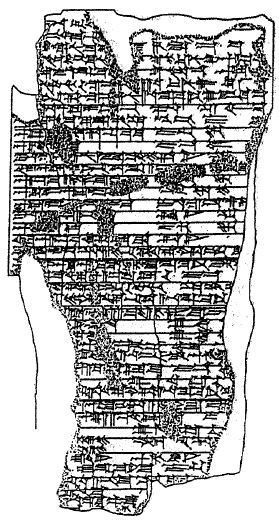
Figure 68
They wandered and reached a
land called Dunnu (the Bible’s ‘Land of Nod’?); there their leader,
named Ka’in (!), built a city whose landmark was a twin tower:
He built in Dunnu
a city with twin towers.
Ka’in dedicated to himself
the lordship over the city.
The clue about a city noted for its twin towers is especially
intriguing.
Early human arrival in the Americas via the Pacific
Ocean is not only the latest scientific conclusion, but is in accord
with local native lore both in South and North America.
In
Mesoamerica, the legendary arrival by
boats was from an ancestral land of Seven Caves or Seven Shrines
(Fig. 69, from a pre-Aztec Nahuatl codex).
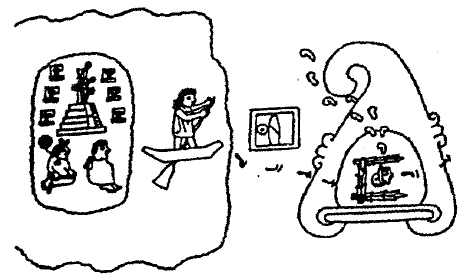
Figure 69
Pointing out the
parallels with the 7-7-7 in the Cain/Lamech line, I wondered in
The Lost Realms and in
When Time Began
whether the name of the Aztec
capital, Tenoch-titlan (= ‘City of Tenoch’), now Mexico City, might
have really meant ‘City of Enoch’, a city known when the Spaniards
arrived by its twin-towered Aztec temple (Fig. 70).
I also
speculated whether the ‘Mark of Cain’, which had to be noticed and
recognized by others on sight, could have been the Mesoamerican
men’s absence of facial hair.
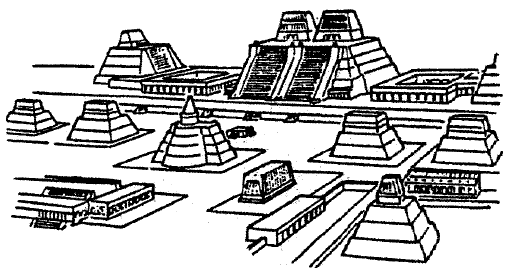
Figure 70
The text’s similarities to the biblical story of Cain’s wanderings
and the city he built are obvious - but the presumption is that all
that took place within the geographic embrace of the Near East.
A
transpacific jump to the Americas nevertheless refuses to vanish,
because the detail of four brothers marrying their sisters and
founding a new city is the core of the main Legends of Beginnings of
the native peoples of South America.
There (as detailed in The Lost
Realms) the legend was of the four Ayar Brothers who married their
sisters, went wandering, and founded the great city of Cuzco with
its temple; they found the correct site for this "Navel of the
Earth" with the aid of a golden wand given them by the god
Viracocha
(= ‘Creator of All’).
As one remains confounded by these similarities, one thing can be
asserted with certainty: If the legends (and the people) traveled,
it was from the Near East to the Andes, not vice versa.
If that is
how it happened, then we have here a segment of Mankind that might
have survived the Deluge without Noah’s ark, offering a human
genetic lineage without the intermarriage intrusion.
* * *
Without a pause, the Bible follows the Lamech/777 verses with the
information that back home,
"Adam knew his wife again, and she bore
a son, and she called his name Sheth" - ‘Seth’ in English - a
wordplay name meaning in Hebrew ‘Granted’, "for God hath granted
another seed instead of Abel whom Cain had slain."
Seth, let it be
noticed, is not just another son - he is "another seed."
"And to
Seth, to him also a son was born, and he called his name Enosh; it
was then that calling by the name of Yahweh began".
(Genesis 4:26)
The Bible’s words thus make clear that with the birth of Enosh to
Seth, a new genealogical/genetic line has been launched; it leads
straight to Noah and thus to the post-Diluvial surviving ‘Seed of
Mankind.’
The name Enosh is not difficult to explain:
It means, in Hebrew,
"Human" in the sense of ‘One Who Is Frail/Mortal’.
It stems from the
same root as the term Enoshut, and undoubtedly coming from the
Akkadian Nishiti; both mean "Humanity, Humankind".
It is clear
that it is this human lineage (as distinct from the one through the
exiled Cain) that is involved in the ensuing events, including the
intermarriage with the sons of the Elohim.
The Bible’s emphasis on this genealogical line is expressed by the
‘editorial’ placement and extent of the data.
The line of Cain is
described in eight verses, inserted in chapter 4 of Genesis between
the story of Cain and Abel and the birth (to Adam and Eve) of Seth
and Enosh. To the line through Seth and Enosh, the Bible devotes the
two concluding verses in chapter 4 plus all of chapter 5 and its 32
verses.
The list provides an uninterrupted genealogical chain of ten
pre-Diluvial Patriarchs from Adam to Noah, leaving no doubt that it
is this lineage that led to
Noah and thus to the salvaging of the Seed of Mankind and its
restoration in the aftermath of the Deluge.
Though it is the favored genealogical line, the Bible is stingy with
information about it. With one main exception, the data that the
Bible provides consists of a name, at what age each Patriarch gave
birth to his firstborn son, and how long he lived thereafter.
But
who were they, by what were they distinguished, what were their
occupations?
The only aspect of their lives that is evident right
off is that they were blessed with impressive longevity:
Adam lived 130 years and begot a son in his likeness and after his
image, and called his name Sheth.
And the days of Adam after he had begotten Sheth were 800 years; and
he begot [other] sons and daughters.
[So] all the days that Adam lived were 930 years, and he died.
And Sheth lived 105 years and begot Enosh.
And Sheth lived after he had begotten Enosh 807 years,
and he begot
sons and daughters.
And all the days that Sheth lived were 912 years,
and he died.
The list continues in the same manner for the next four Patriarchs -
Enosh begets Kenan at 90, lives another 815 years, begets other sons
and Slaughters, dies at age 905. Kenan begets Mahalalel at 70, dies
at 910; Mahalalel begets Yared (‘Jared’ in English) at 65, dies at
age 895; Yared begets Enoch at age 162, dies at age 962.
There was an extraordinary occurrence when it came to the seventh
Patriarch, Enoch, who,
"lived 65 years and begot Methuselah," but did
not die because, at age 365, "Elohim had taken him."
We shall return
to this significant revelation shortly; right now we shall continue
the record of the subsequent Patriarchs to complete their list and
their age counts:
Methuselah gave birth to Lamech at age 187 and died at age 996.
Lamech gave birth to Noah at age 182, died at age 111.
Noah gave birth to Shem, Ham, and Japheth at age 500;
he was 600 years old when the Deluge swept over the Earth.
While on the face of it these numbers indicate remarkable longevity
(which is expected of those closer to the genetic infusion), the
list suggests that the Patriarchs lived to see not just children and
grandchildren, but also great-grandchildren and
great-great-grandchildren and beyond - and died just ahead of the
Deluge.
Thus, in spite of their extraordinary longevities, it took a
mere 1,656 years from Adam to Noah:
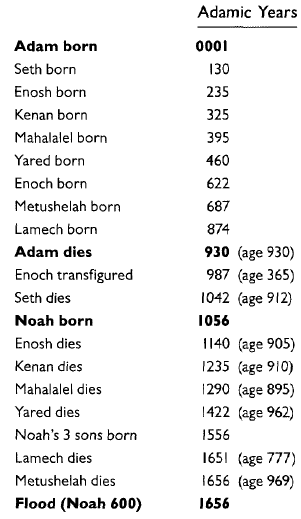
Odd or not, this lineage list of ten pre-Diluvial Patriarchs,
leading to the hero of the Deluge and to the story of the Deluge,
unavoidably
invited scholarly efforts to compare it with the ten ante-Diluvial
kings of Berossus and his sources - not an easy task, since the
Bible’s mere 1,656 years from Adam’s birth to the Deluge is quite
different from the
432,000 years of Berossus (or the totals according to WB-62, WB-444,
etc.):
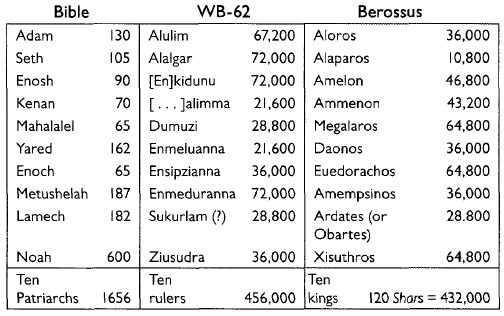
There have been numerous scholarly attempts of numerical gymnastics
aimed at finding some common denominator between the 1,656 years and
the Mesopotamian numbers; none are convincing or reasonably
acceptable.
Our own attempt (in Divine Encounters), focusing on the
obvious Noah/Ziusudra identity and thus the 600:36,000 relationship,
pointed out that since the numeral "1" in cuneiform could also mean
"60" depending on its position, it could well be that the biblical
redactor reduced the ages by a factor of 60.
That would mean a span
of 99,360 (1,656 x 60) years from Adam to Deluge - still not enough
to close the gap.
That the numbers don’t add up is no wonder, for the usual computing
method is wrong to begin with. The Mesopotamian count begins with
the arrival of the Anunnaki (120 Sars before the Deluge); the Adamic
count should begin not from the same moment, but from the time of
fashioning The Adam - 40 Sars later - and even later still, from
when the individual called Adam’ was born. Furthermore, the
Mesopotamian list gives the lengths of reign, which at best should
be compared to when Patriarchal succession took place, not when a
son was born.
Using life-span figures rather than birth-of-son dates, and
multiplying those ages by 60, results in a better ‘Berossus-like’
range: Adam’s 930 would become 55,800 years, Seth’s 912 will be
54,720, the 905 of Enosh 54,300, and so on.
Added together, the ten
life spans (with Enoch’s count stopped at 365 and that of Noah’s at
600) come to a grand total of 8225, which multiplied by 60 results
in 493,500 years. Assuming that succession sometimes took place
before the predecessor’s death, we come within range of the
Mesopotamian totals.
A better track worth following might be comparing personalities,
using their names and/or occupations as clues. Could we find, for
example, the point in the Mesopotamian ten-kings lists where the
biblical Adam makes an appearance? It seems that we can, if we look
carefully.
Of the first two rulers, we definitely know that they reigned in
Eridu, the first Anunnaki settlement established by Ea/Enki. Both
bore typical early Anunnaki’ names; in all probability, Alulim was
Alalu, the deposed Nibiruan king, appointed Chief Administrator
(‘king’) in Eridu by his son-in-law Ea/Enki. Alalgar, whose name
conveyed the notion of ‘settling down’, is not otherwise known, and
could have been one of Enki’s aides.
The interesting point about their reigns, as recorded in WB-62, is
that together they totaled 139,200 years - just under the 40 Shars
(= 144,000 years) of Anunnaki toil before ‘Workman’ was fashioned.
It seems as the right moment for The Adam, born to toil, to appear.
And indeed, it is here that the Mesopotamian list names third ruler Amelon - "The Workman" in Akkadian - a rendering that matches the
Sumerian Lulu-Amelu. Looking at his name in the WB-62 list, the
answer stares right into our eyes: Enki.dunnu simply and clearly
means in Sumerian "Enki made/fashioned him. "
In the Akkadian ‘Amelon’ and the Sumerian ‘Enki.dunnu’, I suggest,
we are staring at the biblical ‘Adam’.
WB-62 then lists two names:
The incomplete [. . . ]-Alimma and "Dumuzi,
a shepherd."
The names and their sequence give us pause; incredibly, Alim means, in Sumerian, ‘Grazing land’ or its animal, the ram;
Dumu.zi literally means "Son who is Life."
Could these Sumerian
names stand for Adam’s sons Abel, the Herder, and then Seth, the son
through whom new Line of Life was granted?
Various studies comparing the biblical list of Patriarchs with the
Berossus list have already suggested that Ammenon in Berossus stems
from the Akkadian (and Hebrew) term for craftsman/artificer, Amman -
a description befitting the biblical Kenan (= ‘Artificer of
Implements’). Without dwelling on the rest of the names, the
instances thus far given strongly suggest one common source for the
various Sumerian King Lists, Berossus, and the Bible.
Our analysis and findings go beyond the conclusion that somewhere,
somehow, there had to be a common source from which the data was
obtained.
For if the Sumerian pre-Diluvial rulers and the biblical
pre-Diluvial Patriarchs were the same, it raises the questions:
-
Who,
indeed, were these Patriarchs?
-
If Adam and Seth and Enosh, etc.,
lived and ‘reigned’ for periods counted in Shars, could they have
been mortal men (as the Bible implies)?
-
If they were the Shar-span
rulers of the Sumerian King List, why the repeated biblical
statement that each one of them died?
-
Or were they perhaps a
combination of the two: partly mortal men, partly gods - in other
words, Demigods - with all the genetic consequences thereof?
-
Could the biblical Patriarchs themselves, including Noah, have been
the very "Men of Renown" of Genesis chapter 6 who were fathered by
the Nefilim who had mated with the ‘Daughters of Man’?
For an answer - an amazing answer - we have to take another look at
all the available sources.
THE POWER OF SEVEN
Our daily life is regulated by the seven-day week - an odd number
that fits neither our decimal (= ‘Base ten’, as the number of our
digits in two hands) system, nor the Sumerian sexagecimal (= ‘Base
Sixty’) system that we continue to use in geometry, astronomy, and
timekeeping.
This unusual choice is explained by the biblical tale
of Creation that covered the span of seven days (the final day of
rest and review included). This biblical seven is explained in turn
by the seven tablets of Enuma elish, the Mesopotamian Epic of
Creation. But why is that text inscribed on seven tablets?
The number seven (including seventh and seventy) appears in almost
every major biblical event, commandment, and prophecy, for a total
of some six hundred times. It is also a key number in the New
Testament, including the prophetic Book of Revelation, as well as in
the Pseudoepigraphic books (such as the seven classes of angels in
the Book of Enoch).
That has been the same in Egyptian lore, starting with the affairs
of the gods: The first divine dynasty consisted of seven gods (from
Ptah to Horus); and in all there were 49 (= 7 x 7) divine and
demigod rulers until Pharaonic reign began. Mesoamerican beginnings
are attributed to seven tribes; and so on.
The consideration of seven as a Power Number in fact began with the
Anunnaki who had come to Earth from Nibiru. Nippur, Mission Control
Center, was the seventh city on Earth. There were seven Sages, and
the ‘Seven Who Judge’. Ziggurats had seven stages, and stars were
located with the "stylus of seven numbers."
A god had the ‘Sevenfold
Weapon’, and there were seven ‘Weapons of Terror’. The release of
the Bull of Heaven triggered seven years of famine; when a temple
was inaugurated, seven blessings were pronounced. And so on and on.
The origin of all that, we suggest, is the position of Earth as the
seventh planet from the viewpoint of the Anunnaki (see the sky map
of Enlil’s route from Nibiru to Earth, Fig. 65).
It states that "Enlil
went by seven planets" to reach Earth - starting the count with,
-
Pluto
-
then Neptune and Uranus as 2nd and 3rd
-
Saturn and Jupiter as
4th and 5th
-
Mars as 6th
-
Earth as the Seventh Planet
Accordingly, seven dots was Earth’s celestial symbol, as seen on an
Assyrian monument (alongside the symbols for the Moon, Nibiru, and
the Sun, and the deities associated with them).
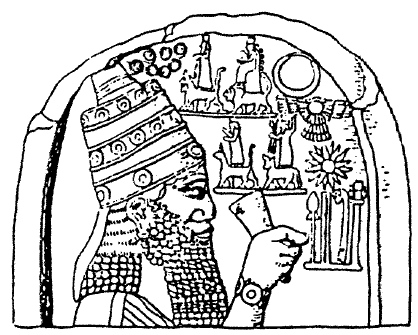
Back to Contents
|





